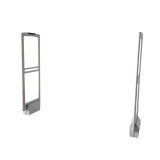Are you a shop owner looking to enhance the security of your merchandise? An electronic article surveillance (EAS) system can be a valuable investment for your business, helping to prevent theft and minimize losses. In this B2B guide, we will explore all the essential factors to consider when buying an electronic article surveillance system for your shop.
Understanding the need for an electronic article surveillance system
The retail industry faces the challenge of combating theft, both from internal and external sources. Shoplifting and employee theft can lead to significant losses for businesses. That’s where an electronic article surveillance system comes in. This system includes tags or labels attached to merchandise and sensors placed at store exits. It helps detect and deter theft by setting off an alarm if an unpaid item passes through the sensors.

1. Identifying your shop’s security requirements
Every shop has unique security requirements. Before investing in an electronic article surveillance system, take the time to assess your specific needs. Consider factors such as the size of your shop, the layout, the types of merchandise you sell, and any previous security incidents you may have experienced. This information will help you determine the appropriate level of security and the type of EAS system that best suits your shop.
2. Choosing the right type of EAS system
Several types of EAS systems are available in the market, each with advantages and considerations. Here are the most common types:
- Acousto-magnetic (AM) system: EAS AM systems offer excellent detection and is suitable for high-traffic areas. It is compatible with a broader range of merchandise and can be used with hard tags and labels.
- Radiofrequency (RF) system: EAS RF systems are widely used and offer good detection. They are more cost-effective than AM systems but may have limitations when detecting certain types of merchandise.
- Electro-magnetic (EM) system: EM systems are known for their high detection rates and compatibility with various tag formats. However, they may be more susceptible to interference from metal objects.
Consider your shop’s specific requirements, the merchandise you sell, and your budget when selecting the right EAS system for your business.
3. Understanding tag options
The tags used in an EAS system are crucial for its effectiveness. There are two main types of tags:
- Hard tags: These are durable, reusable tags that are attached to merchandise using a locking mechanism. Hard tags provide a visible deterrent to potential thieves.
- Labels: AM labels and RF labels are disposable, adhesive-backed tags that can be applied directly to merchandise or packaging. They are more cost-effective but not as durable as hard tags.
Consider the nature of your merchandise and the level of security you require when choosing between hard tags and labels. Some EAS systems may also offer specialized tags for specific types of merchandise, such as clothing or electronics.
4. Assessing detection rates and false alarms
The effectiveness of an EAS system depends on its detection rates and the number of false alarms it produces. High detection rates ensure the system can detect tagged items passing through the sensors. However, excessively high false alarm rates can cause inconvenience to customers and staff. Look for systems that strike the right balance between detection rates and false alarms to ensure optimal performance.
5. Integration with existing security systems
Consider how an EAS system can integrate with your existing security infrastructure. Some EAS systems can be connected to CCTV cameras, access control systems, or alarm systems, allowing for a more comprehensive approach to security. Integration can provide additional benefits, such as remote monitoring and real-time alerts.
6. Installation and maintenance
Before purchasing an EAS system, consider the installation and maintenance requirements. Will you be able to install the system yourself, or will you require professional assistance? Additionally, ensure that reliable customer support and maintenance services support your chosen system. Regular maintenance and upkeep are essential to keep the system functioning at its best.
7. Cost considerations
Lastly, consider the cost of the EAS system and factor it into your budget. Costs can vary based on the type of system, the number of sensors and tags required, and any additional features or integrations. Remember to compare prices from different suppliers and consider the long-term value and benefits the system will bring to your shop.
Conclusion
Investing in an electronic article surveillance system for your shop is a strategic decision that can significantly enhance your security efforts. By understanding your shop’s unique requirements, choosing the right system, and considering factors such as tag options, detection rates, integration, installation and maintenance, and cost, you can make an informed decision that aligns with your business goals. With an EAS system, you can protect your merchandise and provide a safer shopping experience for your customers.
FAQs
1. What is the difference between RFID and an electronic article surveillance system?
RFID (Radio Frequency Identification) and Electronic Article Surveillance (EAS) serve different purposes. RFID is for tracking and identifying items, providing detailed information, while EAS focuses on preventing theft in retail by triggering alarms at exits if security tags aren’t deactivated. RFID is used for broader applications like supply chain management, while EAS is specifically tailored for retail theft prevention.
2. What is an electronic article?
An electronic article refers to any item with electronic security devices, like security tags or labels. In the context of Electronic Article Surveillance (EAS), these devices trigger alarms if the item exits a store without proper deactivation, helping prevent shoplifting in retail.
3. How are EAS tags deactivated?
EAS (Electronic Article Surveillance) tags are deactivated at the point of purchase using a specialized deactivation device. The deactivation process typically involves passing the tagged item over or near a deactivation pad or zone, which emits a deactivating signal. This signal effectively renders the EAS tag inactive, preventing it from triggering alarms when the customer exits the store.
4. What is the difference between EAS and AM?
EAS (Electronic Article Surveillance) tags are deactivated at the point of purchase using a specialized deactivation device. The deactivation process typically involves passing the tagged item over or near a deactivation pad or zone, which emits a deactivating signal. This signal effectively renders the EAS tag inactive, preventing it from triggering alarms when the customer exits the store.


































